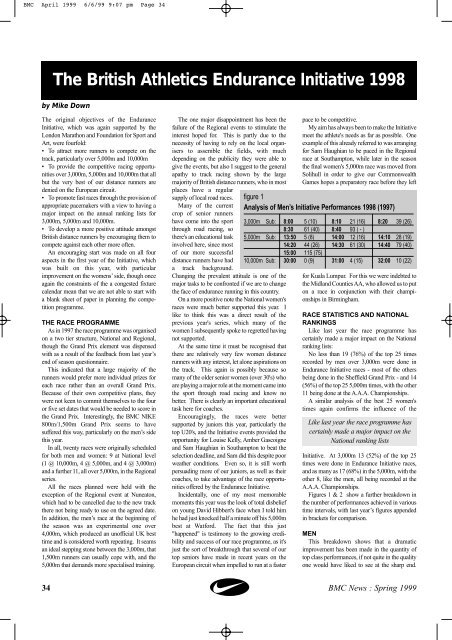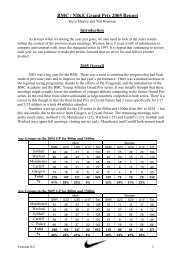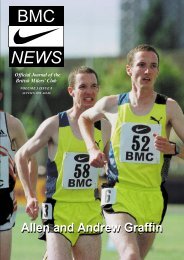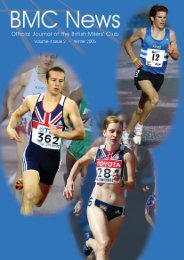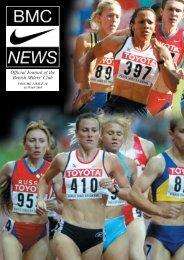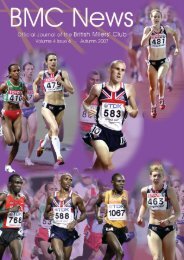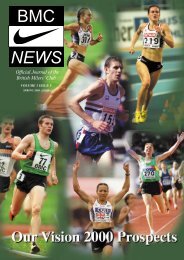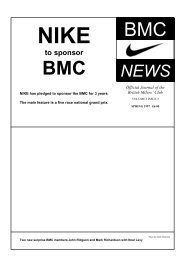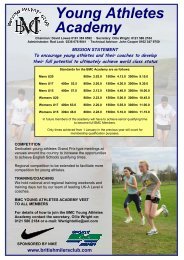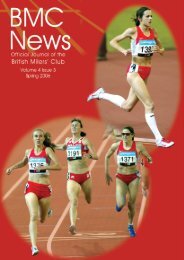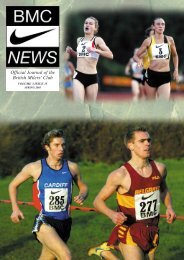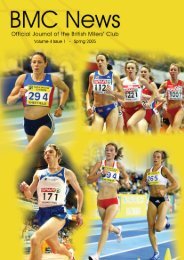Create successful ePaper yourself
Turn your PDF publications into a flip-book with our unique Google optimized e-Paper software.
BMC April <strong>1999</strong> 6/6/99 9:07 pm Page 34The <strong>British</strong> Athletics Endurance Initiative 1998by Mike DownThe original objectives of the EnduranceInitiative, which was again supported by theLondon Marathon and Foundation for Sport andArt, were fourfold:¥ To attract more runners to compete on thetrack, particularly over 5,000m and 10,000m¥ To provide the competitive racing opportunitiesover 3,000m, 5,000m and 10,000m that allbut the very best of our distance runners aredenied on the European circuit.¥ To promote fast races through the provision ofappropriate pacemakers with a view to having amajor impact on the annual ranking lists for3,000m, 5,000m and 10,000m.¥ To develop a more positive attitude amongst<strong>British</strong> distance runners by encouraging them tocompete against each other more often.An encouraging start was made on all fouraspects in the first year of the Initiative, whichwas built on this year, with particularimprovement on the womensÕ side, though onceagain the constraints of the a congested fixturecalendar mean that we are not able to start witha blank sheet of paper in planning the competitionprogramme.THE RACE PROGRAMMEAs in 1997 the race programme was organisedon a two tier structure, National and Regional,though the Grand Prix element was dispensedwith as a result of the feedback from last yearÕsend of season questionnaire.This indicated that a large majority of therunners would prefer more individual prizes foreach race rather than an overall Grand Prix.Because of their own competitive plans, theywere not keen to commit themselves to the fouror five set dates that would be needed to score inthe Grand Prix. Interestingly, the BMC NIKE800m/1,500m Grand Prix seems to havesuffered this way, particularly on the menÕs sidethis year.In all, twenty races were originally scheduledfor both men and women: 9 at National level(1 @ 10,000m, 4 @ 5,000m, and 4 @ 3,000m)and a further 11, all over 5,000m, in the Regionalseries.All the races planned were held with theexception of the Regional event at Nuneaton,which had to be cancelled due to the new trackthere not being ready to use on the agreed date.In addition, the menÕs race at the beginning ofthe season was an experimental one over4,000m, which produced an unofficial UK besttime and is considered worth repeating. It seamsan ideal stepping stone between the 3,000m, that1,500m runners can usually cope with, and the5,000m that demands more specialised training.The one major disappointment has been thefailure of the Regional events to stimulate theinterest hoped for. This is partly due to thenecessity of having to rely on the local organisersto assemble the fields, with muchdepending on the publicity they were able togive the events, but also I suggest to the generalapathy to track racing shown by the largemajority of <strong>British</strong> distance runners, who in mostplaces have a regularsupply of local road races.Many of the currentcrop of senior runnershave come into the sportthrough road racing, sothere's an educational taskinvolved here, since mostof our more successfuldistance runners have hada track background.Changing the prevalent attitude is one of themajor tasks to be confronted if we are to changethe face of endurance running in this country.On a more positive note the National women'sraces were much better supported this year. Ilike to think this was a direct result of theprevious year's series, which many of thewomen I subsequently spoke to regretted havingnot supported.At the same time it must be recognised thatthere are relatively very few women distancerunners with any interest, let alone aspirations onthe track. This again is possibly because somany of the older senior women (over 30's) whoare playing a major role at the moment came intothe sport through road racing and know nobetter. There is clearly an important educationaltask here for coaches.Encouragingly, the races were bettersupported by juniors this year, particularly thetop U20's, and the Initiative events provided theopportunity for Louise Kelly, Amber Gascoigneand Sam Haughian in Southampton to beat theselection deadline, and Sam did this despite poorweather conditions. Even so, it is still worthpersuading more of our juniors, as well as theircoaches, to take advantage of the race opportunitiesoffered by the Endurance Initiative.Incidentally, one of my most memorablemoments this year was the look of total disbeliefon young David Hibbert's face when I told himhe had just knocked half a minute off his 5,000mbest at Watford. The fact that this just"happened" is testimony to the growing credibilityand success of our race programme, as it'sjust the sort of breakthrough that several of ourtop seniors have made in recent years on theEuropean circuit when impelled to run at a fasterpace to be competitive.My aim has always been to make the Initiativemeet the athlete's needs as far as possible. Oneexample of this already referred to was arrangingfor Sam Haughian to be paced in the Regionalrace at Southampton, while later in the seasonthe final women's 5,000m race was moved fromSolihull in order to give our CommonwealthGames hopes a preparatory race before they leftfigure 1Analysis of Men’s Initiative Performances 1998 (1997)3,000m Sub: 8:00 5 (10) 8:10 21 (16) 8:20 39 (26)8:30 61 (40) 8:40 93 ( - )5,000m Sub: 13:50 5 (8) 14:00 12 (16) 14:10 28 (19)14:20 44 (26) 14:30 61 (30) 14:40 79 (40)15:00 115 (75)10,000m Sub: 30:00 0 (9) 31:00 4 (15) 32:00 10 (22)for Kuala Lumpur. For this we were indebted tothe Midland Counties AA, who allowed us to puton a race in conjunction with their championshipsin Birmingham.RACE STATISTICS AND NATIONALRANKINGSLike last year the race programme hascertainly made a major impact on the Nationalranking lists:No less than 19 (76%) of the top 25 timesrecorded by men over 3,000m were done inEndurance Initiative races - most of the othersbeing done in the Sheffield Grand Prix - and 14(56%) of the top 25 5,000m times, with the other11 being done at the A.A.A. Championships.A similar analysis of the best 25 women'stimes again confirms the influence of theLike last year the race programme hascertainly made a major impact on theNational ranking listsInitiative. At 3,000m 13 (52%) of the top 25times were done in Endurance Initiative races,and as many as 17 (68%) in the 5,000m, with theother 8, like the men, all being recorded at theA.A.A. Championships.Figures 1 & 2 show a further breakdown inthe number of performances achieved in varioustime intervals, with last yearÕs figures appendedin brackets for comparison.MENThis breakdown shows that a dramaticimprovement has been made in the quantity oftop class performances, if not quite in the qualityone would have liked to see at the sharp end.34BMC News : <strong>Spring</strong> <strong>1999</strong>


